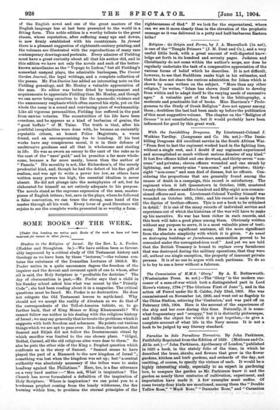With the Inniskilling Dragoons. By Lieutenant - Colonel J. Watkins Yardley. (Longmans
and Co. 16s. net.)—The Innis- killing Dragoons did excellent service in the South African War. "From first to last the regiment worked hard in the fighting line, without a single rest, and I doubt if any regiment experienced and accomplished so much without serious disaster of any kind." It lost five officers killed and one drowned, and thirty-seven "non- corns." and privates ; eleven officers wounded and one struck by lightning, and seventy-nine "non-corns." and privates ; thirty- eight "non-corns." and men died of disease, but no officers. Con- sidering the proportions that are generally found among the causes of death in a campaign, this record is satisfactory. The regiment when it left Queenstown in October, 1899, mustered twenty-three officers and.five hundred and fifty-eight non-commis- sioned officers and men. Lieutenant-Colonel Yardley himself was wounded on October 16th, 1900; and his record is made up from the diaries of brother-officers. This is not a book to be criticised in detail.' It is one of the many records of individual service and experience out of Which the historian of the war will have to make up his narrative. No war has been richer in such records, and this book will take a good place among them. Obviously written without any purpose to serve, it is a most valuable piece of testi- mony. Here is a significant sentence, all the more significant from the absolute simplicity with which it is given. "As usual on destroying buildings or farmhouses, ammunition proved to be concealed under the corrugated-iron roof." And yet we are told that the British Treasury is bound to replace every farmhouse that was destroyed during the military operations, that they were all, without one single exception, the property of innocent private persons. It is of no use to argue with such partisans. To do so is to try to use a lever without a fulcrum.










































 Previous page
Previous page